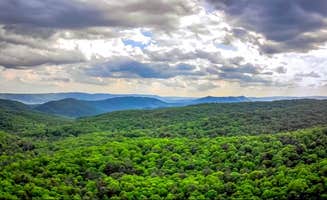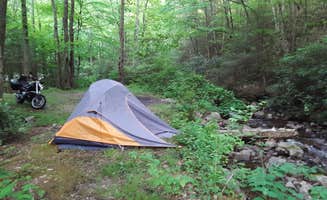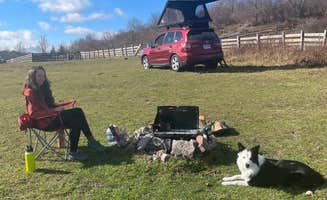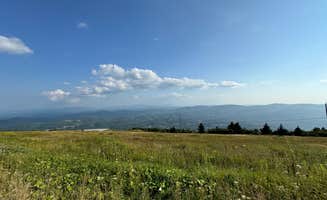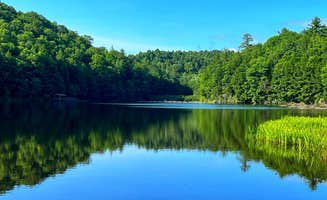The Washington and Jefferson National Forest surrounding Ivanhoe, Virginia contains over 1.8 million acres of public land with numerous free camping options. Most dispersed sites sit at elevations between 2,500-5,000 feet, creating distinct microclimates that campers should prepare for. Weather conditions can shift rapidly, particularly in spring and fall months when temperature swings of 30+ degrees can occur within 24 hours.
What to do
Fishing opportunities: Several creeks surrounding the dispersed sites near Ivanhoe provide excellent fishing. At Little Tumbling Creek, campers can enjoy "good fishing along the way in tumbling creek" with the added bonus of "Laurel bed lake at top is beautiful. Waterfalls on way up," according to reviewer Betsy W.
Trail access: Many campsites offer proximity to premier hiking trails. At Mount Rogers National Recreation Area, campers gain access to "the AT provides some great hiking" as Katie B. notes. The Virginia Creeper Trail is accessible from many sites, offering 34 miles of cycling opportunities.
Wildlife viewing: The region hosts unique wildlife viewing opportunities. Camper Mateo M. shared that at Scales Trailhead, "the salt lick for the ponies wasn't far" and wild ponies are frequently spotted. Sunrise wildlife viewing is particularly productive in summer months when animals are most active early.
What campers like
Creek-side sites: The sound of running water is consistently rated as a top feature. At Washington & Jefferson National Forest Dispersed Sites, campers appreciate that "the creek's sound is pleasant" as noted by Sagar B., while Erik C. adds that "the sound of the creek was lovely all night."
Stargazing: Clear mountain nights offer exceptional stargazing. Lindsay S. reports from Mount Rogers that "the night sky was one of the most memorable moments from our trip. I've never seen so many stars!" Areas above 4,000 feet elevation typically provide the clearest views.
Solitude: Many sites offer true seclusion. Sean reported that at Washington & Jefferson National Forest Dispersed Sites, their camping spot "is very secluded from people" while Alexandra T. described her experience as "Beautiful, Quiet, Off-Grid. Loved this spot - we got lucky and parked right next to a swimming hole, had a gorgeous swim and enjoyed our time."
What you should know
Road access challenges: Many dispersed camping areas require capable vehicles. At Scales Trailhead Basecamp, Jon M. warns of "serious off road capability needed. The road in is....'rocky'. High clearance 4wd needed." Some sites require 45+ minutes of difficult driving from main roads.
Free camping availability: Free camping near Ivanhoe, Virginia ranges from established sites to primitive pull-offs. At Walnut Flats, Alice S. notes "This is a wonderful spot. It has five established camp sites with fire rings and picnic tables. The bathroom is a pit style but it was still clean and didn't smell."
Weather extremes: Mountain weather can create challenging camping conditions. At Whitetop, Whitney B. cautions that "if there's any clouds in the sky, you're literally just in a cloud of condensation. Everything is wet. Only camp here if there's clear sky's. Even then, the wind is killer and probably never lets up."
Cell service limitations: Connectivity is nearly non-existent at most sites. Sean confirms "Absolutely no verizon service at the site" at Little Tumbling Creek, while Alice S. notes at Walnut Flats that "There is no internet access but there is enough signal you can get text sometimes. You need to drive about ten minutes to the gas station to get dependable coverage."
Tips for camping with families
Safety considerations: First-time dispersed campers should choose sites carefully. Glennie V. advises to "Be aware of your surroundings and always carry something on you to protect yourself!" For families with young children, sites closer to roads may offer greater security.
Established sites: For families new to dispersed camping, Walnut Flats offers a balanced experience. SomadNomad M. shares it has "about 5 sites with grill fire rings level gravel drive with tent pad and lantern pole, restrooms... well water pump for drinking water."
Swimming opportunities: Creek-side sites often feature natural swimming areas. Alexandra T. recommends finding spots "parked right next to a swimming hole" which can provide built-in entertainment for children during summer months when water levels are safe.
Tips for RVers
Site accessibility: Most dispersed sites have limitations for larger vehicles. At Whitetop, Emerald M. warns "The road to this site is WILD, but doable! I'll leave photos of the worst spots to help you decide whether or not you should drive up to the top." Only vehicles with good clearance should attempt access to higher elevation sites.
Length restrictions: Few dispersed camping areas near Ivanhoe can accommodate larger RVs. Dennis R. notes that at Walnut Flats, he "stayed in the double site" which offers more room for setups. Most sites have natural barriers limiting vehicle length to under 25 feet.
Self-contained requirements: No hookups exist at dispersed sites. SomadNomad M. shares their experience: "I stayed just shy of 2 weeks and... worked on our rv without any disturbances" but campers must bring all water, power, and waste management solutions.


